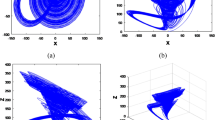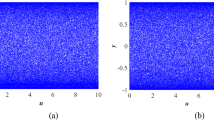Abstract
Recent studies on terrestrial vertebrates have unveiled a correlation between fear of predators and a reduction in anti-predator defenses, leading to a significant decline in prey reproduction. Given the critical importance of prey population levels, we have introduced a fear factor into a discrete-time predator–prey model to investigate its influence on the complex and dynamic behavior of the system This research primarily focuses on assessing the local stability of both trivial and boundary equilibrium points and exploring the criteria for Neimark–Sacker and period-doubling bifurcations. Moreover, we have applied chaos control techniques to identify the stability region and corroborated our theoretical findings through experimental data. Unlike previous research, our study incorporates chaos control methodology and experimental data validation. Consequently, it contributes significantly to the comprehension of predator–prey interactions by incorporating the influence of fear on prey reproduction. Furthermore, this research introduces novelty and reliability for future investigations by integrating chaos control techniques and validating the findings using experimental data.








Similar content being viewed by others
References
Lotka, A.J.: Elements of Physical Biology. Williamsand Wilkins, New York (1925)
Volterra, V.: Variazioni e fluttuazioni del numero d’individui in specie animali conviventi. Societá anonima tipografica Leonardo da Vinci (1927)
Creel, S.D., Christianson, D.: Relationships between direct predation and risk effects. Trends Ecol. Evol. 23(4), 194–201 (2008)
Wang, X., Zanette, L., Zou, X.: Modelling the fear effect in predator-prey interactions. J. Math. Biol. 73(5), 1179–1204 (2016)
Cresswell, W.: Predation in bird populations. J. Ornithol. 152(1), 251–263 (2011)
Abramsky, Z., Rosenzweig, M.L., Subach, A.: The costs of apprehensive foraging. Ecology 83(5), 1330–1340 (2002)
Elgar, M.A.: Predator vigilance and group size in mammals and birds: a critical review of the empirical evidence. Biol. Rev. 64(1), 13–33 (1989)
Preisser, E.L., Bolnick, D.I.: The many faces of fear: comparing the pathways and impacts of nonconsumptive predator effects on prey populations. PLoS ONE 3(6), 24–65 (2008)
Creel, S., Christianson, D., Liley, S., Winnie, J.A.: Predation risk affects reproductive physiology and demography of elk. Science 315(5814), 960–960 (2007)
Hik, D.S.: Does risk of predation influence population dynamics? Evidence from cyclic decline of snowshoe hares. Wildl. Res. 22(1), 115–129 (1995)
Pierce, B.M., Bowyer, R.T., Bleich, V.C.: Habitat selection by mule deer: forage benefits or risk of predation. J. Wildl. Manag. 68(3), 533–541 (2004)
Partridge, B.L., Johansson, J., Kalish, J.: The structure of schools of giant bluefin tuna in Cape Cod Bay. Environ. Biol. Fishes 9, 253–262 (1983)
Zanette, L.Y., White, A.F., Allen, M.C., Clinchy, M.: Perceived predation risk reduces the number of offspring songbirds produce per year. Science 334(6061), 1398–1401 (2011)
Sasmal, S.K., Takeuchi, Y.: Dynamics of a predator-prey system with fear and group defense. J. Math. Anal. 481(1), 123–471 (2020)
Panday, P., Pal, N., Samanta, S., Chattopadhyay, J.: Stability and bifurcation analysis of a three-species food chain model with fear. Int. J. Bifurcat. Chaos. 28(1), (2018)
Liu, J., Lv, P., Liu, B., Zhang, T.: Dynamics of a predator–prey model with fear effect and time delay. Complexity. 2021 (2021)
Mahapatra, G.S., Santra, P.K., Bonyah, E.: Dynamics on effect of prey refuge proportional to predator in discrete-time prey-predator model. Complexity 2021, 1–12 (2021)
Hossain, M., Pal, S., Tiwari, P., Pal, N.: Bifurcations, chaos, and multistability in a nonautonomous predator-prey model with fear. Chaos 31(12), 123–134 (2021)
Santra, P.K., Mahapatra, G.S.: Dynamical study of discrete-time prey-predator model with constant prey refuge under imprecise biological parameters. J. Biol. Syst. 28(03), 681–699 (2020)
Barman, D., Roy, J., Alrabaiah, H., Panja, P., Mondal, S.P., Alam, S.: Impact of predator incited fear and prey refuge in a fractional order prey predator model. Chaos Solitons Fractals 142, 110–420 (2021)
Roy, J., Barman, D., Alam, S.: Role of fear in a predator-prey system with ratio-dependent functional response in deterministic and stochastic environment. Biosystems 197, 104–176 (2020)
Duarte, J., Januário, C., Martins, N., Sardanyés, J.: Chaos and crises in a model for cooperative hunting: a symbolic dynamics approach. Chaos 19(4), 43–102 (2009)
Pal, S., Pal, N., Samanta, S., Chattopadhyay, J.: Effect of hunting cooperation and fear in a predator-prey model. Ecol. Complex. 39, 100–770 (2019)
Arditi, R., Perrin, N., Saïah, H.: Functional responses and heterogeneities: an experimental test with cladocerans. Oikos 60(1), 69–75 (1991)
Zhang, H., Cai, Y., Fu, S., Wang, W.: Impact of the fear effect in a prey-predator model incorporating a prey refuge. Appl. Math. Comput. 356, 328–337 (2019)
Sih, A.: Optimal behaviour: can foragers balance two conflicting demands. Science 210(4473), 1041–1043 (1980)
Gilliam, J.F., Fraser, D.F.: Habitat selection under predation hazard: test of a model with foraging minnows. Ecology 68(6), 1856–1862 (1987)
Lima, S.L., Dill, L.M.: Behavioural decisions made under the risk of predation: a review and prospectus. Can. J. Zool. 68(4), 619–640 (1990)
Santra, P.K., Mahapatra, G.S., Phaijoo, G.R.: Bifurcation analysis and chaos control of discrete prey-predator model incorporating novel prey-refuge concept. Comput. Math. Methods 3(6), 1–17 (2021)
Wang, J., Cai, Y., Fu, S., Wang, W.: The effect of the fear factor on the dynamics of a predator-prey model incorporating the prey refuge. Chaos 29(8), 83–109 (2019)
Hossain, M., Pal, S. Samanta, S., Chattopadhyay, J.: Fear induced stabilization in an intraguild predation model. Int. J. Bifurc. Chaos 30(4), (2020)
Qiao, T., Cai, Y., Fu, S., Wang, W.: Stability and Hopf bifurcation in a predator-prey model with the cost of anti-predator behaviors. Int. J. Bifurc. Chaos 29(13), 1950185 (2019)
Sasmal, S.K.: Population dynamics with multiple Allee effects induced by fear factors–a mathematical study on prey-predator interactions. Appl. Math. Model. 64, 1–14 (2018)
Upadhyay, R.K., Mishra, S.: Population dynamic consequences of fearful prey in a spatiotemporal predator-prey system. Math. Biosci. Eng. 16(1), 338–372 (2018)
Allen, M.C., Clinchy, M., Zanette, L.Y.: Fear of predators in free-living wildlife reduces population growth over generations. Proc. Natl. Acad. Sci. USA 119(7), (2022)
Agarwal, R.P., El-Sayed, A.M.A., Salman, S.M.: Fractional-order Chaos system: discretization, bifurcation and chaos. Adv. Differ. Equ. 2013(1), 320 (2013)
Yuan, L.G., Kuang, J.H.: Stability and a numerical solution of fractional-order Brusselator chemical reaction system. J. Fract. Calc. Appl. 8(1), 38–47 (2017)
Pal, S., Pal, N., Chattopadhyay, J.: Hunting cooperation in a discrete-time predator-prey system. Int. J. Bifurc. Chaos 28(07), 1850083 (2018)
He, Z., Lai, X.: Bifurcation and chaotic behaviour of a discrete-time predator-prey system. Nonlinear Anal. Real World Appl. 12, 403–417 (2011)
Liu, X., Xiao, D.: Complex dynamic behaviours of a discrete-time predator-prey system. Chaos Solitons Fractals 32, 80–94 (2007)
Li, B., He, Z.: Bifurcations and chaos in a two-dimensional discrete Hindmarsh-Rose model. Nonlinear Dyn. 76(1), 697–715 (2014)
Chen, Q., Teng, Z., Hu, Z.: Bifurcation and control for a discrete-time prey-predator model with Holling-IV functional response. Int. J. Appl. Math. Comput. Sci. 23(2), 247–261 (2013)
Cheng, L., Cao, H.: Bifurcation analysis of a discrete-time ratio-dependent predator-prey model with Allee effect. Commun. Nonlinear Sci. Numer. Simul. 38, 288–302 (2016)
Ishaque, W., Din, Q., Taj, M.: Mutual interference and its effects on searching efficiency between predator-prey interaction with bifurcation analysis and chaos control. J. Vib. Control 29(5–6), 1031–1045 (2023)
Din, Q., Ishaque, W., Iqbal, M.A., Saeed, U.: Modification of Nicholson-Bailey model under refuge effects with stability, bifurcation, and chaos control. J. Vib. Control 28(23–24), 3524–3538 (2022)
Jing, Z., Yang, J.: Bifurcation and chaos in discrete-time predator-prey system. Chaos Solitons Fractals 27(1), 259–277 (2006)
Marotto, F.R.: Snap-back repellers imply chaos in \(R^{n}\). J. Math. Anal. 63(1), 199–223 (1978)
Marotto, F.R.: On redefining a snap-back repeller. Chaos Solitons Fractals 25(1), 25–28 (2005)
Chen, G., Fang, J., Hong, Y., Qin, H.: Controlling Hopf bifurcations: discrete-time systems. Discrete Dyn. Nat. Soc. 5, 29–33 (2000)
Chen, G., Yu, X.: On time-delayed feedback control of chaotic systems. IEEE Trans. Circuits Syst. 46(6), 767–772 (1999)
Wen, G.L., Xu, D.L., Xie, J.H.: Controlling Hopf bifurcations of discrete-time systems in resonance. Chaos Solitons Fractals 23(5), 1865–1877 (2005)
Ott, E., Grebogi, C., Yorke, J.A.: Controlling chaos. Phys. Rev. Lett. 64(11), 1196–1199 (1990)
Romeiras, F.J., Grebogi, C., Ott, E., Dayawansa, W.P.: Controlling chaotic dynamical systems. Physica D 58(1–4), 165–192 (1992)
Ogata, K.: Modern Control Engineering, 2nd edn. Prentice-Hall, New Jersey (2010)
Hi, X., Li, C., Pan, X., Peng, M.: Impulsive control and Hopf bifurcation of a three-dimensional chaotic system. J. Vib. Control 20(9), 1361–1368 (2014)
Ghandchi-Tehrani, M., Wilmshurst, L.I., Elliott, S.J.: Bifurcation control of a Duffing oscillator using pole placement. J. Vib. Control 21(14), 2838–2851 (2015)
Mobayen, S., Baleanu, D., Tchier, F.: Second-order fast terminal sliding mode control design based on LMI for a class of non-linear uncertain systems and its application to chaotic systems. J. Vib. Control 23(18), 2912–2925 (2017)
Acknowledgements
The authors thank the main editor and anonymous referees for their valuable comments and suggestions leading to improvement of this paper. This research work was funded by Higher Education Commission (HEC) Pakistan under NRPU Project No. 20–16985/NRPU/R &D/HEC/2021.
Author information
Authors and Affiliations
Contributions
All authors reviewed the manuscript.
Corresponding author
Ethics declarations
Conflict of interest
The authors declare no competing interests.
Additional information
Publisher's Note
Springer Nature remains neutral with regard to jurisdictional claims in published maps and institutional affiliations.
Rights and permissions
Springer Nature or its licensor (e.g. a society or other partner) holds exclusive rights to this article under a publishing agreement with the author(s) or other rightsholder(s); author self-archiving of the accepted manuscript version of this article is solely governed by the terms of such publishing agreement and applicable law.
About this article
Cite this article
Ishaque, W., Din, Q., Khan, K.A. et al. Dynamics of Predator–Prey Model Based on Fear Effect with Bifurcation Analysis and Chaos Control. Qual. Theory Dyn. Syst. 23, 26 (2024). https://doi.org/10.1007/s12346-023-00878-w
Received:
Accepted:
Published:
DOI: https://doi.org/10.1007/s12346-023-00878-w
Keywords
- Predator–prey model
- Fear effect
- Stability
- Neimark–Sacker bifurcation
- Period-doubling bifurcation
- Chaos control




